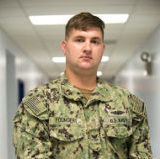As citizens of Marine City go about their daily lives, members of the U.S. Navy’s “Silent Service” work beneath the ocean’s waves, continuing a tradition that only a small fraction of military members will ever know: strategic deterrence. Petty Officer 2nd Class Eric Youngert assigned to USS Alaska hails from Marine City, Michigan, and is a 2010 graduate of Marine City High School who takes on the task to execute one of the Defense Department’s most important mission of strategic deterrence. Youngert is a machinist mate (nuclear) stationed at the Naval Submarine Base Kings Bay, homeport to the Ohio-class ballistic-missile and guided-missile submarines.
“Naval Submarine Base Kings Bay is home to all East Coast Ohio-class submarines,” said Rear Adm. Jeff Jablon, commander, Submarine Group 10. “Team Kings Bay ensures our crews are combat ready when called upon, putting our submarine forces on scene, unseen.” “I operate and maintain Navy nuclear propulsion plants and associated equipment; supervise and administer naval nuclear propulsion operations,” Youngert said. Youngert credits continued success in the Navy to many of the lessons learned in Marine City. “I learned to always have a positive attitude,” Youngert said. The Navy’s ballistic-missile submarines (SSBNs), often referred to as “boomers,” serve as a strategic deterrent by providing an undetectable platform for submarine-launched ballistic missiles, according to Jablon. They are designed specifically for stealth, extended patrols and the precise delivery of missiles if directed by the President. The Ohio-class design allows the submarines to operate for 15 or more years between major overhauls. On average, the submarines spend 77 days at sea followed by 35 days in-port for maintenance.
Youngert is part of the boat’s blue crew, one of the two rotating crews, which allow the boat to be deployed on missions more often without taxing one crew too much. A typical crew on this submarine is approximately 150 officers and enlisted sailors. The first submarine was invented by Yale graduate, David Bushnell, in 1775 and provided the colonists with a secret weapon in the form of a one-man wooden craft in an experimental submarine that was nicknamed the Turtle.
Although Bushnell’s efforts were unsuccessful in attempts to blow up British vessels during the American Revolution George Washington said of the Turtle, “I then thought, and still think, that it was an effort of genius.” U.S. submarines may not be what some have imagined. Measuring 560 feet long, 42-feet wide and weighing more than 16,500 tons, a nuclear-powered propulsion system helps push the ship through the water at more than 20 knots (23 mph). Because of the demanding environment aboard submarines, personnel are accepted only after rigorous testing, according to Navy officials. Submariners are some of the most highly-trained and skilled people in the Navy. Regardless of their specialty, everyone has to learn how everything on the ship works and how to respond in emergencies to become “qualified in submarines” and earn the right to wear the coveted gold or silver dolphins on their uniform. “At this command, the people are nice, the morale is good, it’s like having a family aboard a ship,” Youngert said. Serving in the Navy means Youngert is part of a world that is taking on new importance in America’s focus on rebuilding military readiness, strengthening alliances and reforming business practices in support of the National Defense Strategy. A key element of the Navy the nation needs is tied to the fact that America is a maritime nation, and that the nation’s prosperity is tied to the ability to operate freely on the world’s oceans. More than 70 percent of the Earth’s surface is covered by water; 80 percent of the world’s population lives close to a coast; and 90 percent of all global trade by volume travels by sea. “Our priorities center on people, capabilities and processes, and will be achieved by our focus on speed, value, results and partnerships,” said Secretary of the Navy Richard V. Spencer. “Readiness, lethality and modernization are the requirements driving these priorities.” Though there are many ways for sailors to earn distinction in their command, community, and career, Youngert is most proud of the qualifications he earned to receive his submarine warfare pin. “You study long and hard for it but it pays off in the end,” Youngert said.
As a member of one of the U.S. Navy’s most relied upon assets, Youngert and other sailors know they are part of a legacy that will last beyond their lifetimes providing the Navy the nation needs. “Serving in the Navy means I get the rare chance, that many don’t, to serve my country and protect my family and friends,” Youngert said.
Story written by: M. Dawn Scott, Navy Office of Community Outreach
Photo by Mass Communications Specialist 2nd Class Brad Gee


